Adobe Acrobat PDF Reader is already installed on your computer, this is one thing you’re sure of. But every time you click a link to a PDF, you get a big paragraph of an error message which starts with: “Adobe Acrobat Reader has not been installed on your computer…” – but if you save the PDF and open it, it works fine. It’s a strange glitch I’ve seen more than a few times in Adobe Reader. Here’s the quick fix: (more…)
Author: gec
-
Download the Windows 8 Release Preview Here

Microsoft has published the link for the Windows 8 Release Preview. This is, for all intents and purposes, Windows 8 Release Candidate 1, and is expected to be the final official “release” of Windows 8 until the final retail version is released later this year. Enjoy.
-
Botnets getting frightening
I work in the IT industry, and when I read about the United States government urging large corperations and Internet Service Providers to volunteer their information in order to stop the spread of botnets and viruses, it gets a little more frightening than usual. (more…)
-
Show or Hide Formatting (extra characters) in Word 2007 / 2010
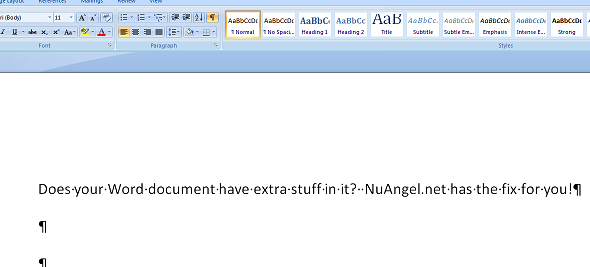
Do you have extra formatting characters or funny symbols in your Word Document? Do you have dots between every word in MSWord? Or are you proofing something so carefully that you might actually WANT those characters but don’t know how to turn them on? Here’s how you can easily switch them off and on. (more…)
-
Ninite installs and updates your PC's programs all at once
A friend of mine introduced me to a website called Ninite. Trust me, I didn’t want to click the link while I was at work, either. Especially not when it come in an email that said nothing more than “you’re welcome. 😉” Still, I gave it a shot, and wanted to give this a plug as well. Again, I’m not normally in to tools and applications, I’m more about real techinical information you can use – but this may be helpful to people who build lots of machines.
Ninite.com is the reverse of last week’s mentioned PC Decrapifier. It installs multiple applications on your computer at once. When you first head to their home page at Ninite.com you’re greated with a large page of checkboxes. Check the applications you want to install, then click the large “Get installer” button at the bottom of the page.
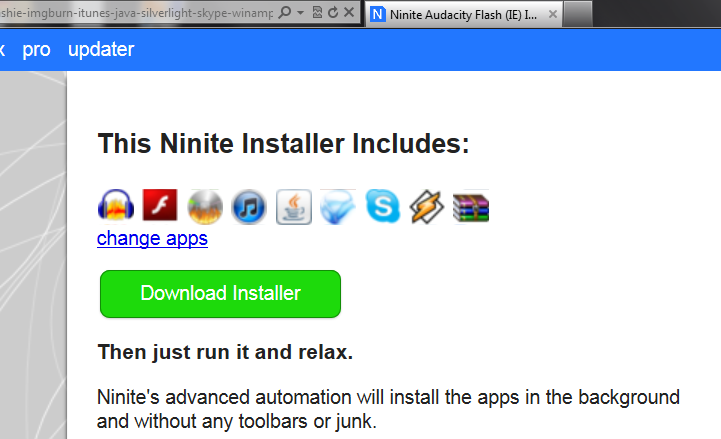
The next page showed me a page of installers I had selected with another big green button that said “download installer.” I clicked on that and away it went. Now, I ran this on a computer which I had been using for a while with several outated applications on it. I can easily see the benefits of using a tool like this to roll several applications out to a new computer that never had anything on it before, it sounds great and simple – but it also touts itself as an application updater, and I wanted to see how well that feature performed. To my jaw dropping surprise? Like a charm. In less than five minutes, I was notified that the work was complete by this Window:
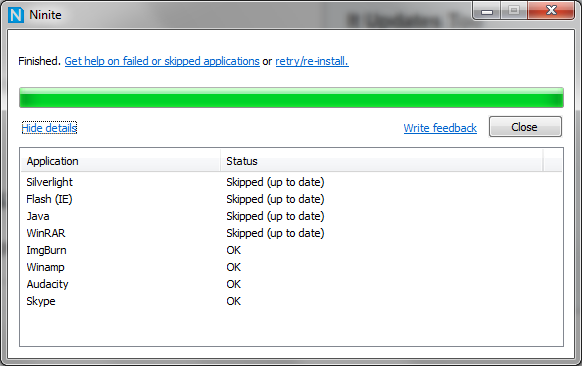
Ninite detected the application that did not require updating and did not bother downloading the installers for those applications. This saved both time and bandwidth, especially considering some of the applications I had selected were on the substantially sized side of things! So there it is, two weeks in a row I’m plugging an application to batch uninstall programs, and a program to mass-install programs. Hopefully next week we’ll get back in to the really geeky stuff!
-
First impressions of the new iPad

I am a life long Windows junkie, but I love getting my hands on new technology and tinkering with something fresh and new. Linux (CentOS, Mint, Ubuntu, Arch, and others), Mac OS, Windows Mobile, Android, Windows Phone 7, Palm OS, and the HP Touchpad are all devices and operating environments that I have tinkered with within the last year. I really love getting to play with new tech, but sometimes people ask what I think of a device and I really have to think hard about it before I just spout off glorious praise, or damning criticism. The 3rd generation iPad is one of those devices.
Truth be told, I am writing this on the new iPad, but I am still adjusting to it. So why don’t I just give some of my initial impressions, since I am only about 72 hours in to my ownership and still on my first battery charge. (more…)
-
PC Decrapifier makes quick work of removing bloatware
Bloatware is the term that geeks in the computer industry call of that junk that comes preinstalled on your computer when you buy it from the store. To uninstall all of the programs that HP, Dell, Acer, Sony, Fujitsu, ASUS — any of’em put on your computer, it can be quite a chore. You don’t want Xobni games, you don’t want the trial version of Office Home and Business, you don’t want a trial of Quickbooks… you just want your computer. Well, even though I don’t usually talk about tools, this one is a time saver and I think people should know about it.
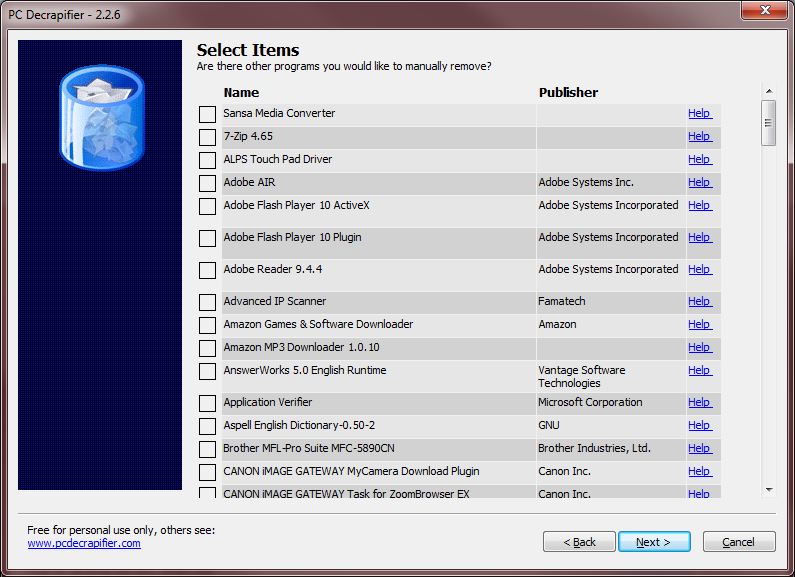
To do a mass unisntall of several programs on your computer, there’s only one good tool out there: PC Decrapifier. After a quick installation, you can let it find the most common bloatware, or you can go through a list of all of the installed programs and run through them yourself. Although the process isn’t 100% automated, it will save you from scrolling through your “add/remove programs” list or “Programs and Features” to find the applications you want to uninstall one at a time. The occasional uninstall screen may prompt you for a few additional mouse clicks, but the rest of the process will just roll on. You make the decisions once, and away you go. I encourage you to head on over to PCDecrapifier.com and check it out!
In the interest of disclosure for anyone interested, this is a completely unsolicited endorsement of an application I find quite useful. Revo Uninstaller is a similar application, I just like the ease of PC Decrapifier better, personally.
-
Archive by date RECEIVED instead of date MODIFIED in Outlook 2007
Some people have a lot of email. A lot of email. Sometimes, to boost performance and ease the strain on your servers, it can be a good idea to archive that email. But what happens when you want to archive a batch of messages, only to find out that, supposedly, several of your messages don’t qualify as “old enough” to meet the archival requirements you’ve set up? “They should,” you think to yourself, “they’re several years old!” The problem becomes – what if you just migrated that user’s email account to a new PC, and now the modified date is more recent than the received date. A buddy of mine ran in to this recently and shared the solution with me for all of you Outlook 2007 users.
People have many stances on holding off on updates, but I’m pretty sure this one’s been around long enough to qualify for the “it oughtta be there by now” standard. But if you’re working on an old computer for someone and you haven’t been in control of the Windows Update cycles, you may want to check for KB2412171. Although it’s not expressly described in the KB article, my friend originally found some helpful details on the website MSOutlook.info and I want to give credit where credit is due. But, rather than just linking off to any other website that could disappear some day (nothing more frustrating than clicking dead links in forums) I figured I would at least link you to the KB article and help you out. The more places that share the details of the fix, the better.
This update adds the option to archive by date received, rather than simply by date modified, which (as I explained) can leave you stuck sometimes. Getting all of your Office updates – or at least downloading and installing KB2412171 for Office 2007 should fix you right up! Mail will be archived based on when it was received, and calendar appointments based on their scheduled dates – no more of this “date modified” junk!
-
One or more parameter values are not valid (Outlook error) Solved!
Recently, I came by an error message I hadn’t seen before in Outlook 2007 & 2010. Upon hitting the “send” button, immediately the computer would pop up an error message, which reads: “Could not complete the operation, one or more parameter values are not valid.” You didn’t even have time to see if the message sent – it wouldn’t send at all. It turns out, what had happened, was that the address in Outlook’s address had book had somehow become corrupted. I won’t pretend to know what caused the problem, but I will provide you with a quick and easy solution.
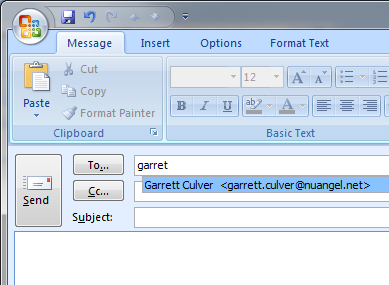
- Start a new email message.
- Begin typing the address of the person you’re sending to.
- When it appears in the drop down, highlight it using the arrow keys on your keyboard.
- So you don’t forget it, I advise WRITING DOWN the email address now.
- Press the DEL (DELETE) key on your keyboard.
- Now RE-TYPE (do not copy and paste) the email address you are sending to.
- Enter a message and send it!
You shouldn’t have ANY problems when you click the send button after that!
-
Windows Phone 7’s only problem

Windows Phone 7 is a beautiful operating system. It is an environment that is unapologetically different from the things that came before it. It is efficient, fast, simple, vibrant, easy to use, distinct, professional, and fun. It’s so many different things at once that you think it would be confusing, or contradicting… but it isn’t. At every turn and from every angle, Windows Phone 7 has it’s act together. Sure people mention that some apps are missing from Windows Phone 7, but really there is only one big problem with Windows Phone 7: t doesn’t solve any problems that the other options competitors in the field don’t already solve. (more…)
-
Know your Windows 8 Editions (Chart!)

click to open full sizeWord recently broke that despite all of the various version names previously spotted in Windows 8, Microsoft is going to simplify your life in to four total Windows 8 editions.
The plainly named Windows 8 product will have most of the features you know and love from your average Windows 7 Home Premium installation, including most of the bells and whistles that make Windows 8 an upgrade over Windows 7. Windows 8 Pro will include all of those features plus “encryption, virtualization, PC management, and domain connectivity” according to Microsoft’s WindowsTeamBlog. Microsoft certainly isn’t hiding some of the things which will be trimmed from Windows 8, but they are doing a good job of making sure you don’t notice.
One major feature to go missing, which has been available since Windows XP, will be the ability to act as a remote desktop host. You should be to access terminal servers remotely, but accessing your computer at home is going to require more than knowing what ports to forward on your home router – you’re most likely going to need to use a third party application, like GoToMyPC or LogMeIn, or TeamViewer, etc… also, disappearing from Windows 8 (all versions) is Windows Media Center. Ever since XP’s Media Center Edition, Microsoft has tried to gain living room acceptance of their media center software – and right when the era of the “Home Theater PC” is really starting to pick up steam… Microsoft decides to bail out on us. It’s very strange. Windows Media Center will be a premium tool which you can purchase through their Windows 8 Marketplace, supposedly on Windows 8 Pro edition computers only. So you must already own a Windows 8 Pro license, then you will have to buy Windows Media Center separately. This seems like it could be either their biggest mistake yet, or their most brilliant decision to make money hand over fist by charging for the one feature they hope will be a big deal this generation. Still, I find people more likely to find an alternative solution like a GoogleTV or AppleTV box, or even just by installing the free version of Boxee on their PC.
Next, there will be the tablet version, Windows RT, which, although not 100% confirmed feature-wise, is rumored to be the successor to Windows Phone 7: a “metro-only” OS in the style of Windows 8, stripping out the Desktop mode and compatability with your current generation of Windows 7 applications. A chart on Microsoft’s Team Windows Blog does contradict some of this, but without true compatability with x86 applications, having access to the “desktop” interface seems to me like a smoke and mirrors feature to make you feel at home. Again, all rumor and personal opinion, especially until we get closer to launch and see what the “Windows on Arm” or WOA team has come up with. Microsoft has confirmed it will lose Windows Media Player, but hopefully the device will have an equally impressive media player built in as that seems to be one of the biggest uses I’ve heard from anyone who owns a tablet: the ability to consume video content on the go.
These three editions have a feature chart which is available on the WindowsTeamBlog website, along with a description of the fourth, yet still vague, Windows 8 Enterprise Edition. Not unusual for peopel with “Software Assurance” (meaning they get the free upgrade to the next version of Windows), the Enterprise Edition was recently known as ‘everything that was in Windows 7 Ultimate, except the games’ (which could be enabled if the user wanted them). Since there will no longer be an “Ultimate Edition” – people are trying to figure out what Microsoft’s vague announcement of Windows 8 Enterprise means, when it was vaguely described as including “all the features of Windows 8 Pro plus features for IT organization that enable PC management and deployment, advanced security, virtualization, new mobility scenarios, and much more.”
-
How CISPA is both BETTER and WORSE than SOPA
CISPA supporters say that the bill has nothing to do with seeking out people who pirate movies and music, and shouldn’t be looked at as the next SOPA. Although I think the true goals of the CISPA Cybersecurity bill are more innocently motivated, and the overall efforts of the bill should even be applauded, the problem isn’t what the bill contains. CISPA wants to allow business to share information about hackings and cyberthreats with government agencies – to more quickly identify and respond to cyberattacks. Imagine a network of information sharing, where large scale business, the likes of Google, Sony, Microsoft, Yahoo, and AOL (you know them now as Engadget, Joystiq, TechCrunch, Huffington Post, et al…) all actually worked together to protect your privacy. All of that is fine. It’s what CISPA leaves out that frightens me the most. Specifically, CISPA leaves out any language that clearly identifies what it should be used for. One could, quite easily, argue that ‘criminal activities’ and ‘hacking’ can simply be defined as file sharing, and thus your information goes to the government and they can have you arrested. You could be strong-armed to stop using BitTorrent by your ISP (even if you argue that your use is not for illegal purposes), by them saying “quit it, or we’ll sick the feds on you.”
CISPA, like nearly every technology-related bill to date seen on Capitol Hill, has vague language that can be interpreted and bent in many, many ways. It does great things at its core, but could easily be twisted in to making something like MP3 swapping a near-felony, if the ambiguous phrasings of the bill were later left up to interpretation by a judge. We shouldn’t throw it out there and sort through it later; the bills proposed should have cleaner language and specific, targeted purposes. These are laws we’re enacting, after all.
And on over to the Electronic Frontier Foundation’s website and see how they break down CISPA for a better understanding of why it’s important that this bill not be enacted as it is right now.
-
How to show hidden files and folders AND file extensions in Windows 7
Sometimes you need to do things a little deeper in the computer than normal, and you need to know what file extension is on the end of a certain file. This can help you prevent silly and confusing names like “picture001.jpg.jpg” or something like that. Additionally, sometimes you need to show hidden files on your computer. It’s pretty easy.
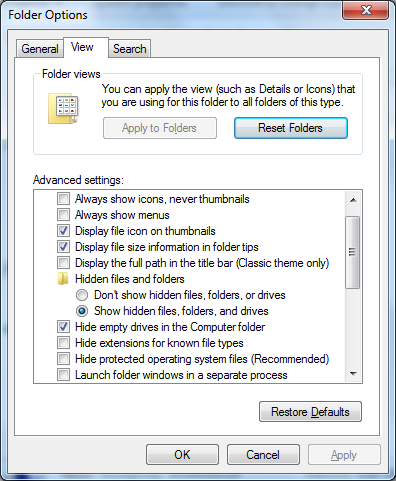
- Open up any folder, I recommend just opening Computer.
- If the menu bar isn’t available at the top, press the ALT key on your keyboard, near the space bar – this will make the menu bar appear: “file, edit, view” appear.
- Click Tools.
- Click Folder options at the bottom.
- Change the Radio Button to Show Hidden Files and Folders.
- Click to uncheck Hide extensions for known file type.
- Also, you can uncheck Hide protected operating systems.
All three of those options can be seen in the screenshot above. Enjoy your new access to your own files!
-
And who are you?
As you may have noticed, I do a little self promotion from time to time. I think every blogger does, we have to. I find it most fascinating when I am practically BOOED away from one social network or another, as though I am just your average spammer. Trust me, the eight cents I earned from AdSense didn’t make it “worth it.”
When I recently posted my own opinions on what Microsoft hopes to accomplish with Windows 8 to various sites, it got mixed reviews. The websites that allowed simple down voting without reason interested me the most. It’s almost as if people are asking questions like “and, who are you?” Or, “why should I care what you think?” Then again, it may have just been people habitually down voting anything with the word “Microsoft” in it.
Still, I pondered the “who am I” question. I suppose I don’t have a direct answer to that. I’m just someone like many of you who have been around computers and technology a long time. I don’t pretend to be a knowledgable source with any insider information… I just look at situations and technologies, then talk about them.
I invite comments on the blog, and even tried to make it easy using Disqus. I just hope people take a little bit of time to learn about me, both personally and professionally, and give a little thought to some of the things I say. If I’m not making any sense, then let’s talk about it in the comments! I’m always interested in what people are thinking.
-
How to Change your Windows 7 Password
Lots of people, whether they’re at home or at work, have passwords on their computer. Now, these are not necessarily passwords to things like your email account if you have GMail or Yahoo Mail or something, and it’s not your Facebook password – just the password to unlock your computer either when you first turn it on, or if you’re coming back to it and it has been on a screen saver for a while. Some people don’t even have passwords set up – but let’s say you’re at a coffee shop – it might be heavily crowded enough that you can go order another drink without someone stealing it, but they may sit down and tinker. If you want to prevent them from doing so, here’s the easiest way to set or reset your password in Windows 7:
- On your keyboard, press Control+Alt+Delete
- On the next screen, select Change a password
- On the final screen, enter your current password (you may not have one at all, in which case just leave the top space blank), then enter your new password twice and press enter or click the blue arrow to the right of the last password field.
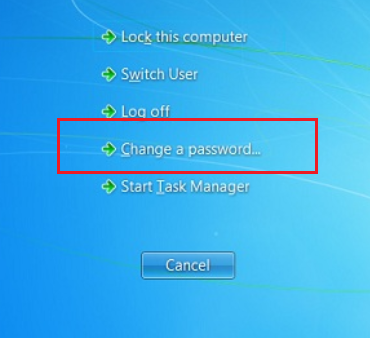
This part calls for a special note: if your computer is a member of a corporate network, you probably want to do this while you are IN the office, otherwise it can cause a few things like Exchange & Outlook based email and other services to get a little crazy. Also, those corporate networks usually have pretty strict security policies, about passwords being changed every so often and being a certain complexity (8 or more characters, no more than 2 sequential characters, upper case letter, lower case letter, number, and symbol, can’t match any of your 20 previous passwords, etc…) – so it may take you a little while to put in a password that the darn thing will accept, but keep plugging away at it. If this is your personal computer, however, and you just use it at home and take it with you on the road, you shouldn’t need to worry about much. Enjoy the peace of mind a fresh new password provides!
UPDATE: If you don’t have your old password and need to “hack” or “crack” you password, you can use the tool NTPassword to do that.
-
My VPN Connects, but I cannot get to anything on the other network
After last week’s posts about VPN Clients, I had some questions about the VPN connections themselves. This is a strange one. It’s very hard to describe without getting too specific, so it may not make good blog-fodder, but hopefully this post will help somebody out. The problem typically goes something like this: I set up a VPN connection to my office. I have the software, whether it’s the Cisco VPN Client, or the SonicWall Global VPN Client, installed on my computer. My connection details are correct, the VPN prompts me for a name and password and takes what I provide. Everything is working up until that point. But then whatever resource I try to use, whether it’s a Terminal Server, a mapped network drive, or a software application on the other side of the VPN, it just doesn’t work.
The resolution is easier than the description. Your local IP range is conflicting with the remote IP schema. It’s not as bad as it sounds. Basically, your home router, out of the box, is most likely configured to give your devices an IP address of 192.168.1.x. If your work or office network was configured the same way, then when you punch in a device IP address when you’re connected to the VPN, then the computer gets confused and doesn’t know whether it should be looking around your house for a certain server or device, or if it should be looking on the other side of the VPN.
The easy fix is to change the IP address of your router. Unless you’ve set static IP addresses, all of your other home devices will automatically pick up the new IP addresses and fix themselves, you shouldn’t have to do anything once you change the router setting itself. For instance, in a Linksys router, you’ll just go to the control page (http://192.168.1.1) and login (probably no username and the password admin, then on the main page, change the local IP address of the router from 192.168.1.1 to pretty much “anything else” in that third octet. Example: 192.168.101.1. It may not make a ton of sense, but whoever is on the other end of the VPN may be able to help you out, and if they weren’t sure what the problem was, this should give them some guidance.
-
Desktops, phones, apps, and the web
I have been listening to discussions among people (and having a few conversations myself) this week, regarding the openness of the web as we know it. This is all discussion generated since the advent of the “post-PC world” Apple has told us that we live in.
I am one of the big proponents of the web. The web should be able to do it all, and as HTML continues to evolve, I feel more and more confident that it will. Apps have the problem of creating a rift in your potential userbase. You have to develop for Android, iPhone, iPad, Windows Phone, and perhaps a few other platforms like BlackBerry. It is because of this very limitation that Windows Phone 7 gets left out of the mania of new game releases. WP7 has only one version of Angry Birds, hasn’t gotten Words with Friends or Draw Something, and generally lacks the constant torrent of new apps that the other major platforms get. If all of those games were available via the web, we wouldn’t have to worry about what platform you were coming from, you could visit the site, and play!
So far, that’s just the mobile space. i have recently decided to rip some of my favorite DVD movies to my own hard drive, and stick the hard copies away in an attic. although i may some day want true “HD” versions of those movies and TV shows, my mid range Xvid rips will make me quite happy. But what tablet was going to let me accomplish that task? And then, where will I store these tons of movies? On my 32GB memory chip? Doubtful. “In the cloud!” some people suggest. Unfortunately, only SkyDrive has any reasonable capacity, and storage on the internet isn’t as cheap and easy as it always seems.
Then come the bandwidth caps. The thing that keeps me on Sprint: unlimited bandwidth. While I rarely use over 2GB per month, I certainly have on more than one occasion. when you look to see where things are going, more and more app and web driven, you have to wonder how we are going to survive with smaller bandwidth caps! A global infrastructure is going to experience growing pains for a while, until we get all the links worked out. Faster speeds, higher caps… We cannot be handcuffed if we are expected or in most cases required to work online.
For me, the desktop PC is still my safe haven. Proven and capable hardware, ever increasing internet speeds, and (so far for me) bimonthly bandwidth caps! It won’t be this way forever, and who knows what the next big thing will be… But I’m excited more and more by every change that comes our way – I just continue to hope that it is something that is open to the web, and not locked away, just for iTunes users, or Android owners, etcetera. Whatever the next step in the web is, whatever the thing AFTER the web is, it has to be for everyone.
-
SonicWall and Cisco VPN Client Download Links
Why is it so hard to download VPN software? Too many times I’ve been in a pinch and needed a VPN client to install for someone. To get the files installed, I have to log in to the website for Cisco or SonicWall and dig around for what I need… for some reason, they lock these things down. You can’t use them without already owning the multi-hundreds-of-dollars piece of hardware, anyway, so why they keep the software under lock and key makes no sense to me. Well, I’ve found some links with the files you need – they aren’t the LATEST versions (in fact, I don’t have the exact version numbers written down), but I can guarantee they work for Windows XP, Vista, 7, as well as your 32-bit or 64-bit needs. I’ve even found a client which, I’m told (I’m not a Mac Guy) works on all versions of Mac OS X (at least up to Lion), if necessary – although with Mac users, IPSEC connections are probably built right in and will work fine. The links are reliable and have been online for a long while, feel free to post below if they ever don’t work for you.
UPDATE 1: SonicWall has gotten the hint that people are tired of hunting. While my links are still available below, SonicWall has finally provided links to the latest Global VPN Clients.
Update 2: WARNING – these downloads are available for your convenience, but please note that I have added approximate dates to files. THEY ARE OLD. They are functional, but they may not be the most compatible with newer operating systems, hardware, or may even have security flaws that have been fixed in newer versions. For the latest Sonicwall client visit their download page. To download the latest Cisco client you must have an active membership with Cisco – your IT department or contractor should be able to obtain the latest versions for you from this page. Again, local downloads are available if necessary, but you should look into getting newer, more secure versions of the software as soon as possible.
Cisco VPN Client 32-bit – 2010 or older.
Cisco VPN Client 64-bit – 2010 or older.
Cisco VPN Client DMG for Mac – 2010 or older.
SonicWall Global VPN Client 32-bit – 2011 or older.
SonicWall Global VPN Client 64-bit – 2011 or older.Enjoy the links!
-
Tablets and Desktops and Ultrabooks, Oh My!
Thursdays are my day to post about whatever I really want. Lately I’ve been thinking a lot about getting myself some new hardware. I don’t do as much computing as I once did. But I feel, simultaneously, like I want to do more. I’ve become that type of geek who used to be a gamer and had to fiddle with his own hardware – now I’m the type of geek who keeps his six year old dinosaur running and also has a netbook.
So I’m thinking of killing two birds with one stone. My desktop I currently hooked up via HDMI to my TV in my living room, running at 1080p, and has a wireless mouse and keyboard (don’t ask what model, it’s embarrassing
). In theory, I could replace both my ailing netbook (with a semi-functional hard drive and a broken left click) and my old desktop (which growls when you first turn it on, squeels when its accessing data, and was “upgraded” to a dual core CPU only about a year ago) with one device. And I love the look of these Ultrabooks. Super portable, super powerful, and most of them have some form of HDMI and of course a USB slot, meaning I could keep it tucked away when not in use, and it would serve as my desktop.
Yeah, that really is a functional computer, the Acer S3These things are loaded, too! I don’t know how they don’t burst into flames. Intel i5’s, i7’s, 8 GB of RAM, terrabyte hard drives, solid state hard drives: you name it, they’ve got a model with it! I haven’t seen any quadcore i7s, yet, and the i7 models are all 15 inches and above – none are 13 inches. I believe that’ due to the necessary heatpiping used in these units, which are mostly passively cooled (heat is dispersed over a wide area, similar to the way tablet or phone “cools” itself, not pushed out with fans like a traditional PC). They carry a heavy pricetag, but everything else out there that I’m looking it is similar to “powerhouse machines” that friends of mine built two or three years ago. I feel like the progression has been towards minimizing the machine, rather than increasing the power. This is one of the reasons I haven’t bothered upgrading my desktop.
Still, the more I work on fun little side projects, the more I have cause to crunch data. I’m getting back in to various forms of media: compressing video as I begin digitzing my DVD collection (more on that later), potentially editing some video for this site, and getting back in to some audio editing and mixing has appealed to me for a while. I also do a lot of work with virtual machines, and wouldn’t you know that my motherboard is so old that I can’t use hardware virtualization on my CPU. No, not even with a hacked BIOS update. Trust me, I’ve checked. It would be nice to virtualize things a little better. In several instances, I feel like the crappy Atom CPU in my netbook does a better job than my desktop.
So, if it’s about time, I need to consider several things. Is it worth it? Is now the time? Are there deals coming down the road, or is everyone excited for tablets and the iPad specifically that there’s no point in going forward? I look at things like the HP Folio
, ASUS Zenbook
, Acer Aspire S3
, and the Samsung Series 5
– which may be a little bit bulkier than the others, but is still impressively tiny, which I kind of like because it actually boasts a full size HDMI port.
What’s everybody else doing? Ignoring it and waiting for Windows 8 tablets? Going for first gen Ultrabooks? Building a new Bulldozer-based gaming PC for only three grand
? Oh decisions decisions. I think I’m going to try and at least hold out until the vouchers for free upgrades to Windows 8 are unveiled, likely to come out some time this summer, but I don’t think I’m going to wait all the way until October when Windows 8 launches – when it’s official, I’ll probably buy a tablet. But what will I end up doing before then? I’ll keep you posted, but if you have any words of advice, leave them in the comments, I’m open to listening!
-
My IT Toolkit
Nothing specific from the help desk today, but I just wanted to refer you to several tools I use frequently in my job. Some of them I have been using for years, and one of them for literally over a decade. These are applications I trust and I use. I am in no way affiliated with any of these products, and am only recommending them because they genuinely work for me! Put some of this stuff on your flashdrive and you’ll have the Swiss army knife of IT toolkits.
Antivirus:
Anti-Malware:
Password Recovery:
Data Recovery:
Drive Imaging:
Now I know some of you may say I left out some other useful tools, or your favorites – this isn’t a comprensive list of everything I use regularly, these are just some of the ones I immediately turn to. I’ll gladly say I also use several resources like RogueKiller and ComboFix from BleepingComputer.com, sites like InternetHealthReport.com to diagnose internet connectivity issues, and use other products like Microsoft Steady State, Comodo Time Machine, RollbackRX for keeping a system in running order, MetaSploit, BackTrack, and ImmunityCanvas for pentesting, and Acronis TrueImage or even Norton Ghost when they’re called for in system imaging. But the list above are some of my favorites. If they’re not working for you, I’d encourage you to find something that will by using AlternativeTo.